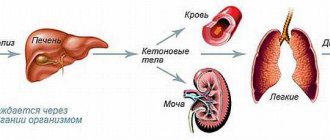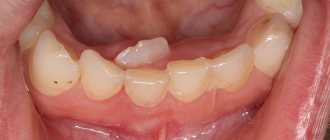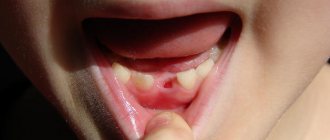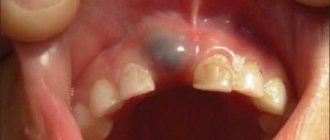Many parents closely monitor the development of their baby, including the appearance of the first baby teeth. This process is remembered for a long time, because during this period the child behaves restlessly, develops a fever, and scratches his gums vigorously. But all these difficulties are worth it in the end to see your child have a mouth full of teeth.
However, it is worth considering that baby teeth are considered temporary, and by a certain age they begin to loosen and fall out. So what to do with a lost baby tooth? For many inexperienced mothers, this process can raise a lot of questions, so it’s worth preparing for this in advance.
At what age do children lose their first teeth?
According to statistics, the first baby tooth leaves the socket when the child turns 5-6 years old. The process of changing teeth occurs gradually (otherwise babies would not be able to chew).
Various factors influence the age at which a baby’s first molars appear:
- health of baby teeth;
- fetal development during pregnancy (the rudiments of teeth appear in the womb);
- characteristics of the baby’s body.
What to do when your first baby tooth falls out?
During the period of changing teeth, the child’s oral cavity needs to be cared for especially carefully. In addition, you need to ensure that the baby’s diet is correct and balanced, because this is also very important for oral health. Here's what to do when your first baby tooth falls out:
- Brush your teeth at least twice a day, preferably every time after meals.
- Use rinses or herbal infusions after meals.
- Contact your dentist in a timely manner for examinations and monitoring of changes in bite.
- Treat caries and other oral diseases in a timely manner.
- If necessary, seal the fissures as a preventive measure.
- Make sure that the child’s menu contains as few harmful foods as possible - too hard, containing fast carbohydrates (all kinds of sweets, confectionery), carbonated drinks.
- Include more foods rich in calcium, phosphorus, and vitamin D in your diet: beef liver, sea fish, eggs, cottage cheese, sour cream, hard cheese, butter.
- Give the child more “correct” solid food to stimulate the resorption of the roots of baby teeth - apples, carrots and other solid vegetables and fruits.
Which teeth fall out first?
Although the age at which primary teeth are replaced by molars varies and is sometimes difficult, the order in which they fall out is the same for almost all children.
- Sixes begin to grow first. These teeth are not baby teeth, but in all children they are the first to make themselves known.
- Then the lower and then the upper incisors begin to loosen.
- After the incisors, a variety of teeth become loose in different orders and fall out.
- The last ones to loosen and fall out are the fangs.
The process of developing a child’s bite lasts quite a long time – up to 13-14 years. And, by the way, if a child’s baby teeth were uneven, this does not mean at all that the molars will grow the same. It is likely that the teenager will be proud of his Hollywood smile. A permanent bite is formed regardless of the past.
Is the child worried?
Many parents worry that when their children lose their baby teeth, they will develop complexes. Actually this is not true. Of course, loose and falling teeth bring physical discomfort to children, however, they do not worry about the unaesthetic appearance. After all, most of their friends also walk around with lost teeth.
When a child's first tooth falls out, the baby may be bothered by the socket that appears as a result of tooth loss. The baby's curiosity inevitably develops, and he constantly tries to touch the socket and the growing molar with his tongue (or even his finger) in order to explore new sensations.
Parents definitely need to explain to their child that this should not be done: your hands can introduce an infection into the mouth, which can cause teeth and gums to become sore.
There is no need to worry if ichor comes out of the hole after a tooth falls out. In this case, you need to let the baby rinse his mouth with a soda solution. If the wound is actively bleeding, you can let the child lightly bite on a cotton pad or gauze pad.
The most common dental injuries
Tooth luxation:
- complete luxation (the tooth has fallen out of its socket)
- partial luxation (the tooth has moved but has not fallen out)
- impacted dislocation (the crown part of the tooth is pressed into the gum and bone; the tooth becomes shorter in appearance, and perhaps it is completely invisible).
Tooth fracture:
- chipped piece of enamel
- chipping of the crown within the dentin without damage to the dental pulp
- fracture of the tooth crown with damage to the pulp (blood is visible at the fracture site)
- tooth root fracture
When teeth are injured, soft tissues (lips and gums), the alveolar process (the bone in which the tooth root is located) and the jaw can be damaged. This creates an additional psychological impact on the victim and people providing assistance. Don't panic and stay calm.
How to behave if your child’s first tooth falls out?
The first baby tooth that falls out is another step towards growing up. So why not mark this event with some interesting ritual for the child, so that further loss will be easier for the baby and bring more joy.
Tooth Fairy
Give your baby a little magic. Let the good sorceress take the first tooth from under the pillow while he sleeps, and in return leave a small gift: candy, a coin or a toy. The next baby tooth that falls out will bring joy to the baby.
Mouse
Another tradition that children really like is to give a lost tooth to a mouse. The mouse will chew the old tooth, and a new one will appear in its place.
Together with your baby, you need to find a secluded corner in the house and put the fallen tooth there. At night, a mouse will run into the corner and take it away.
We hope that falling out baby teeth and emerging permanent teeth will not cause trouble for either children or parents. And to make the first molars give the baby even more joy, we have developed a special Asepta Teens toothpaste to protect and strengthen the enamel of permanent teeth in children over 8 years old. The paste increases the resistance of enamel to bacteria and acids, helps saturate teeth with calcium and phosphorus, and provides effective protection against caries and gum inflammation. And the rich taste of apricot, peach and cream will turn brushing your teeth into a real treat.
How to stop bleeding after tooth extraction
Bleeding after tooth extraction is a natural process, a consequence of surgical intervention. During the operation, the tissues that hold the tooth in the row are damaged. Accordingly, inevitable bleeding occurs. In this material we will tell you in detail how to distinguish normality from pathology, how to properly stop bleeding after tooth extraction, and what kind of help should a doctor provide?
Is bleeding after tooth extraction normal?
After removing a tooth from the socket, blood begins to flow immediately, and the doctor takes measures to weaken the flow. For example, the dentist applies a sterile swab, previously soaked in a special liquid. However, after some time (after 2-3 hours or the next day), the wound may bleed again, catching the patient by surprise on the way home or already at home. The professional must inform the person about this and give some instructions so that the patient can react correctly.
Bleeding after tooth extraction occurs due to the following reasons:
- the dentist damaged a large vessel - often this problem occurs after a complex tooth “comes out” and during an incision in the gum;
- the patient has increased blood pressure - as a result, the vessels do not close, bleeding is activated;
- poor blood clotting – often found in patients suffering from leukemia or hepatitis;
- the patient is taking anticoagulant drugs;
- if there was an infection that provoked inflammation.
Bleeding after tooth extraction is often accompanied by the following symptoms:
- headache and dizziness are observed;
- a person's temperature rises;
- there is weakness, faintness;
- the socket swells;
- blood oozes so much that the patient spits out clots every two to three minutes;
- the person feels severe pain in the surgical area;
- the pain radiates to the temples, neck, ear.
How long does it usually take to bleed after tooth extraction?
It is normal if blood oozes from the wound for about a day. Sometimes it takes two days to stop completely, which is also within normal limits. If a patient has had a wisdom tooth or a “complicated” tooth removed, blood may ooze for about 3 days - this will also be considered normal. If the bleeding bothers you for several days, or the symptoms listed above are observed, you should urgently consult a dentist. It is also an alarming symptom if a blood clot does not form in the socket.
Bleeding after tooth extraction - what can the patient do?
- Take painkillers that were previously selected and recommended by the dentist.
It is strictly prohibited to independently choose medications to relieve pain and stop bleeding.
- Apply a cold bandage or object to your cheek. After holding the cold object for 3 minutes, you can take a break. In one session, you can perform three alternating applications.
Placing ice or cold objects into the hole from which the tooth was removed is strictly prohibited. This can trigger the development of infection and inflammation.
- Apply a gauze swab previously soaked in hydrogen peroxide.
The tampon must be clean and sterile (!) to avoid infection of the wound.
- Take medications to lower blood pressure. As a rule, they are recommended for people suffering from hypertension.
Selecting and prescribing blood pressure medications on your own is strictly prohibited!
Attention! Self-medication can lead to deterioration of health. All medications and other measures to stop bleeding after tooth extraction should be recommended by an experienced dentist.
Professional medical help: how to stop bleeding after tooth extraction?
- The doctor examines the patient and determines the nature of the bleeding - natural or pathological. If necessary, refers the person to x-rays and ultrasound of the tooth;
- the doctor cleans the wound and then dries it.
- The doctor prescribes medications: painkillers, antiseptics, possibly antibiotics.
- Physiotherapeutic procedures are performed if necessary.
- If there are appropriate medical conditions, additional stitches are placed on the wound.
What to do if the bleeding does not stop after tooth extraction? No need to self-medicate! It is imperative to contact a dentist, who will rule out pathological processes or, if they exist, provide emergency assistance. Dentists at Zuub.rf accept patients with acute pain, if there is bleeding after tooth extraction and the person’s condition does not allow them to lead a normal lifestyle.
If you have the symptoms described in this article, be sure to make an appointment at our clinic.
Don't self-medicate! Even the smallest problem, if not treated correctly, can significantly complicate your life.
By contacting us, you can be sure that:
- Get high-quality and free consultation .
- You will receive the best prices for treatment and the opportunity to receive a special promotional price.
- Only modern equipment and materials will be used.
- You will be treated by professional doctors with many years of experience.
- We offer treatment on credit or in installments. There is also the possibility of obtaining a tax deduction.
- We work seven days a week and without a lunch break, from 9 a.m. to 10 p.m.
+7











